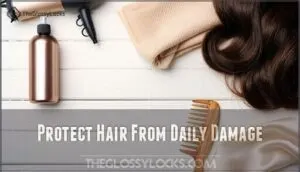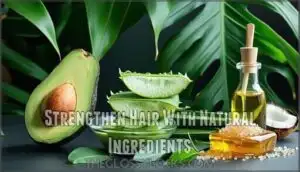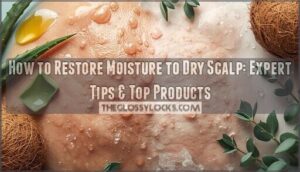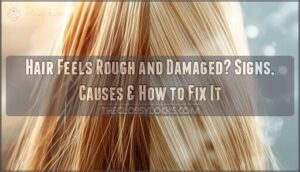This site is supported by our readers. We may earn a commission, at no cost to you, if you purchase through links.
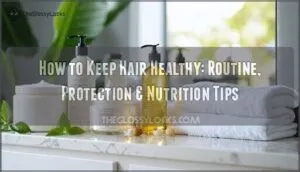
The difference between hair that looks lifeless and hair that actually thrives isn’t about expensive treatments—it’s about consistent habits that protect what’s already growing from your scalp. Here’s what actually works to maintain healthy hair, backed by how your scalp and strands respond to different care approaches.
Table Of Contents
Key Takeaways
- Your hair loses 50-100 strands daily, and protecting what’s already growing through consistent habits—like proper conditioning technique, reducing heat styling, and eating protein-rich foods—matters more than expensive treatments for maintaining strong, healthy strands.
- Small daily adjustments like applying conditioner only from mid-lengths to ends, sleeping on silk pillowcases to reduce friction, and getting trims every 8-12 weeks prevent damage that compounds over time and leads to breakage.
- Natural ingredients like coconut oil, rosemary oil, and aloe vera offer proven benefits for strengthening hair and supporting scalp health without the chemical load of commercial products, especially when used consistently in weekly treatments.
- What you eat directly impacts hair strength—protein fuels keratin production, vitamins C and E boost collagen synthesis, and staying hydrated maintains the 60% water content your strands need to remain flexible and resilient.
Build a Nourishing Haircare Routine
Your hair deserves a routine that actually works, not just a random collection of products you hope will do the trick. Building a solid haircare foundation comes down to a few key practices that protect your strands from root to tip.
Here’s what you need to focus on to keep your hair healthy and strong.
Choose The Right Shampoo and Conditioner
Your hair’s future depends on picking a shampoo and conditioner that actually work with your hair type, not against it. Start by checking ingredient lists for sulfate-free options, which won’t strip your scalp’s natural oils.
Think about your scalp type—oily, dry, or sensitive—and match hair care products accordingly. Hair porosity matters too, since low-porosity strands need lighter formulas while high-porosity hair craves extra moisture.
pH balance keeps your cuticle smooth, so look for products designed to protect it.
Apply Conditioner Correctly
Most people slather conditioner on their roots and wonder why their hair looks greasy an hour later, so let’s talk about the right way to do this. Start with mid-lengths and ends, where hair conditioning matters most for hair moisture. Work upward toward your scalp gradually, focusing conditioner application tips on damaged areas.
Check conditioner ingredients matter labels for hydrating components like oils or proteins.
Leave-in conditioners work differently than rinse-out techniques—the former stays to protect, while traditional formulas need thorough rinsing. This simple shift in your hair care routine makes a real difference in hair health.
Use Weekly Deep Conditioning Masks
Think of deep conditioning as giving your hair a weekly spa day—it’s the step that takes regular conditioning from adequate to truly restorative. Apply your hair mask from mid-shaft to ends, following mask application tips that focus on damaged areas. Choose deep conditioning treatments based on your hair’s needs—protein masks rebuild strength while moisture-focused hair treatments restore hydration.
DIY mask recipes with coconut oil or honey offer great mask ingredient benefits without breaking the bank. Your mask frequency guide? Once weekly for normal hair, twice for severely damaged strands.
Brush Hair Before Showering
Before you even turn on the water, take a moment to run your brush through dry hair—this simple pre-shower ritual prevents tangles from tightening into stubborn knots once water hits them.
Detangling benefits go beyond breakage prevention—your hair brushing methods also promote oil distribution from scalp to ends and provide gentle scalp stimulation. Use wide-tooth combs or soft-bristle best brushes to protect your hair health during this essential hair care routine step.
Protect Hair From Daily Damage
Your hair faces a lot of wear and tear every single day, from heat tools to environmental stressors. Protecting it doesn’t require a complete lifestyle overhaul, just some smart adjustments to your daily habits.
Here are four straightforward ways to shield your strands from damage.
Reduce Heat Styling Frequency
Your flat iron might be convenient, but it’s also draining the moisture right out of your hair with every pass. High heat weakens your strands over time, leading to dryness and breakage.
Try air-drying a few days a week or experimenting with heatless styles like braids.
When you do use heat styling tools, always apply a heat protectant spray first—it’s your best defense against minimizing heat damage.
Shield Hair From UV Rays
Just like UV rays damage your skin, they also weaken your hair. UV exposure can degrade up to 95% of hair’s protective proteins and lipids, leaving strands brittle and faded. Melanin protection varies by hair color—lighter hair is especially vulnerable to scalp sunburn.
UV exposure destroys up to 95% of hair’s protective proteins, leaving strands brittle and faded—especially in lighter hair colors
Hair sunscreen products with broad-spectrum UV filters reduce penetration by about 22%, though product efficacy drops after 1.5 hours. Apply a leave-in UV spray before heading outside, and wear a hat for extra environmental hair protection. Physical barriers like hats are the most reliable UV protection.
Sleep on a Silk Pillowcase
Tossing and turning at night doesn’t just rob you of sleep—it also creates friction that snaps hair like tiny rubber bands. Cotton pillowcases grip your strands, causing hair breakage and tangles by morning.
Switching to a silk pillowcase reduces hair friction by up to 43%, letting your hair glide smoothly as you move. This simple nighttime routine upgrade aids hair maintenance while offering skin benefits too—less creasing and moisture loss overnight.
Get Regular Trims
Split ends don’t heal themselves—they travel up the hair shaft like a run in stockings, weakening every inch they climb. Regular trims every 8-12 weeks stop split end progression before it causes hair breakage throughout your length.
You’ll actually maintain better growth by cutting a quarter-inch regularly than losing inches to damage. Professional haircuts guarantee even removal, while DIY trims risk uneven cuts that compromise hairstyle maintenance.
Fuel Hair Health Through Nutrition
You can’t out-run a bad diet for your hair. What you eat directly affects how strong, shiny, and resilient your strands become.
Let’s look at the key nutritional strategies that help your hair thrive from the inside out.
Eat Protein-Rich Foods
Think of protein as the building blocks your hair is literally made from, and without enough of it, those strands just won’t grow as strong or resilient as they should.
Amino acids from protein sources like fish, eggs, meat, and beans fuel keratin synthesis, which directly shapes your hair structure.
A protein deficiency shows up quickly in hair health, leaving strands brittle and slow-growing, so prioritizing protein in your diet isn’t optional—it’s essential for hair nourishment.
Boost Collagen With Vitamins C and E
Collagen acts like scaffolding for your hair follicles, and vitamins C and E work together to build and protect that structure from the inside out. Vitamin C benefits hair by driving collagen synthesis, while vitamin E benefits come from antioxidant protection that shields follicles from damage.
Load up on these dietary sources for prime hair nourishment:
- Berries for concentrated vitamin C
- Spinach for both vitamins plus iron
- Avocados for vitamin E and healthy fats
- Citrus fruits for collagen-boosting vitamin C
- Nuts and seeds for vitamin E density
Stay Hydrated Throughout The Day
Your hair strands are about 60% water, so when you skimp on hydration, you’re literally starving every follicle of the moisture it needs to stay flexible and strong. Aim for drinking at least 8 glasses a day to maintain scalp hydration and hair moisture from within.
Electrolyte balance matters too—pair your water intake with hydrating foods like cucumber and watermelon to heighten those hydration benefits for lasting hair health and hydration.
Consider Hair-Supporting Supplements
Supplementing smartly can fill nutritional gaps that affect hair growth, but ingredient evidence and supplement efficacy vary widely. Look for biotin, marine collagen, vitamin D, and saw palmetto—ingredients with documented population outcomes in clinical trials. The market growth reflects rising interest, yet usage risks like iron toxicity or selenium overload are real if you self-prescribe without testing your levels first. The hair supplement market is expected to grow considerably.
- Choose multi-ingredient formulas targeting stress, hormones, and oxidative damage
- Prioritize biotin (5 mg daily) when paired with topical treatments for measurable hair growth
- Monitor vitamin D levels and aim for 40–100 ng/ml with oral D3 supplementation
- Avoid excess iron or selenium intake unless deficiency is confirmed by bloodwork
- Expect visible improvements in hair volume and scalp coverage after 90–180 days of consistent use
Strengthen Hair With Natural Ingredients
Sometimes your hair needs a break from store-bought products packed with chemicals you can’t even pronounce. Natural ingredients offer a gentler way to strengthen strands, nourish your scalp, and boost growth without breaking the bank.
Here are four tried-and-true options that actually work.
Coconut and Argan Oil Treatments
If you want to see real transformation in your strands, coconut and argan oils are two of the most powerful treatments you can reach for.
Coconut oil penetrates the hair shaft to strengthen from within, while argan oil seals the cuticle and adds shine.
For a DIY hair treatment, warm the oil slightly, apply it from mid-length to ends, and leave it on for 30 minutes before shampooing—once weekly works well for most hair types.
Aloe Vera for Scalp Health
While oils work wonders on your strands, a healthy scalp is where strong hair actually begins—and aloe vera is one of the gentlest, most effective ingredients you can use to keep it balanced. It’s naturally rich in enzymes that remove dead cells, soothe irritation, and restore pH balance to support ideal scalp health.
Aloe benefits include:
- Hydrates the scalp without leaving greasy residue
- Controls dandruff through gentle cleansing action
- Provides irritation relief for sensitive or inflamed areas
- Balances scalp pH to prevent excessive oil or dryness
- Strengthens hair follicles with vitamins and minerals
Apply pure aloe vera gel directly to your scalp twice weekly for natural hair care that works.
Rosemary Oil for Growth
Among natural remedies that boost scalp circulation and show scientific evidence for hair growth, rosemary oil stands out. This oil extraction stimulates blood flow to hair follicles, potentially blocks DHT (a hormone linked to hair loss), and promotes overall hair health through regular application methods.
| Benefit | How It Works | Usage Frequency |
|---|---|---|
| Stimulates growth | Increases scalp circulation | 2-3 times weekly |
| Blocks DHT | Reduces follicle miniaturization | Daily application |
| Strengthens strands | Nourishes with antioxidants | Mix with carrier oil |
Dilute a few drops in coconut or jojoba oil before massaging into your scalp for best results in hair care.
Egg Masks for Protein Boost
When you crack an egg, you’re holding one of nature’s most complete protein packages—and it works just as well on your hair as it does in your body.
Egg masks deliver protein directly to each strand, strengthening weak spots and improving elasticity.
Mix one or two eggs with olive oil or honey for a nourishing hair treatment, apply it to damp hair, and rinse after 20 minutes for noticeable results.
Frequently Asked Questions (FAQs)
How often should you wash your hair?
Most people do well washing their hair two to three times per week, but your ideal hair washing frequency depends on scalp oil production, hair texture types, and activity level impact.
Overwashing strips natural oils and causes product buildup effects, while signs of overwashing include dryness or irritation—adjust your hair care routine based on how your scalp feels.
What causes hair to become dry and brittle?
Like soil left parched too long, strands crack when stripped of moisture. Heat damage from styling tools, chemical treatments, environmental factors like sun and wind, product buildup blocking hydration, and poor scalp health all steal your hair’s natural oils, leading to dryness and brittleness.
Can stress affect your hairs health and growth?
Stress absolutely impacts hair health and growth. Elevated cortisol levels from chronic stress can trigger telogen effluvium, pushing follicles into a resting phase that causes excessive hair shedding.
Managing stress through relaxation techniques helps reduce scalp tension and fosters healthier hair growth.
How do you prevent hair breakage while sleeping?
Silk pillowcases reduce friction that causes hair breakage while you sleep. Protective hairstyles like loose braids prevent tangling, and nighttime hydration with a leave-in treatment keeps strands strong. Gentle detangling before bed also helps protect your hair.
Whats the best way to detangle wet hair?
Start detangling at the ends using a wide-tooth comb, working your way up gradually. Apply conditioner first to add slip and reduce hair breakage.
Gentle techniques prevent hair damage better than rushing through knots, protecting strands when they’re most vulnerable during post-shower care.
Conclusion
Healthy hair habits happen consistently, not occasionally. The way you treat your strands—from scalp to ends—through proper conditioning, heat protection, and balanced nutrition directly impacts whether your hair strengthens or breaks down over time.
You’ve learned how to keep hair healthy through small, intentional choices that compound into visible results. Your hair reacts to what you do daily, so make each action count toward the resilience and vitality you want to see.





